*
Hotel Reviews

I came to Phuket for all the right reasons: wellbeing, Muay Thai training, clean living. Then one morning I thought, what the hell, I need a break from all this healthiness. A few hours later, I was in Thalang swapping protein shakes in Chalong for coconuts, checking into The Slate, one of Bill Bensley’s most intriguing and unapologetically bold creations.
Low season in Phuket means two things: sudden tropical downpours and hotel rates that feel like a well-kept secret. I’m talking half-price luxury, shout out to my travel agent Liv&Travel for the bargain. I was only here for a day before moving on to review Anantara Mai Khao and another resort, but even in that short stay, it was obvious that The Slate wasn’t just a hotel; it was a story told in steel, timber, and tin.
I’ve been a fan of Bill’s work for years. He’s behind some of the world’s most remarkable hotels, Capella Ubud, Rosewood Luang Prabang, The Siam in Bangkok, InterContinental Danang, JW Marriott Phu Quoc, Four Seasons Tented Camp Golden Triangle, Shinta Mani Wild in Cambodia. Each one feels like it’s been dreamt up after a particularly vivid night’s sleep and then built with painstaking detail.
Having worked in design for years, I’ve heard stories about Bensley, the kind that make you both admire his genius and wonder how his mind works. Watch his interviews and you’ll see what I mean: he’s as colourful as the spaces he creates.
Before Bensley arrived, this was the Pearl Village Hotel, a serviceable but “uninspired” beachfront resort. It had the location, but not the personality. Interiors were beige-on-beige, buildings felt disconnected from their surroundings, and the architecture could have been anywhere from the Caribbean to the Canary Islands.
After Bensley, it’s unrecognisable. He gutted and reimagined the place, keeping only the footprint of some original structures while reworking everything else to serve a narrative, a tribute to Phuket’s tin-mining heritage. Out went generic stucco facades; in came steel beams, reclaimed hardwood ceilings, and walls clad in authentic rusted tin panels salvaged from mining sites. Landscaping went from decorative to immersive, dense tropical planting wraps around villas and public areas, creating pockets of privacy and a sense of exploration. Pathways, once straight and purely functional, now curve deliberately to frame views or hide surprises. Even the lighting was rethought low, warm glows that bounce off aged metal, polished concrete, and dark timber, giving the resort a moody, cinematic feel at night.
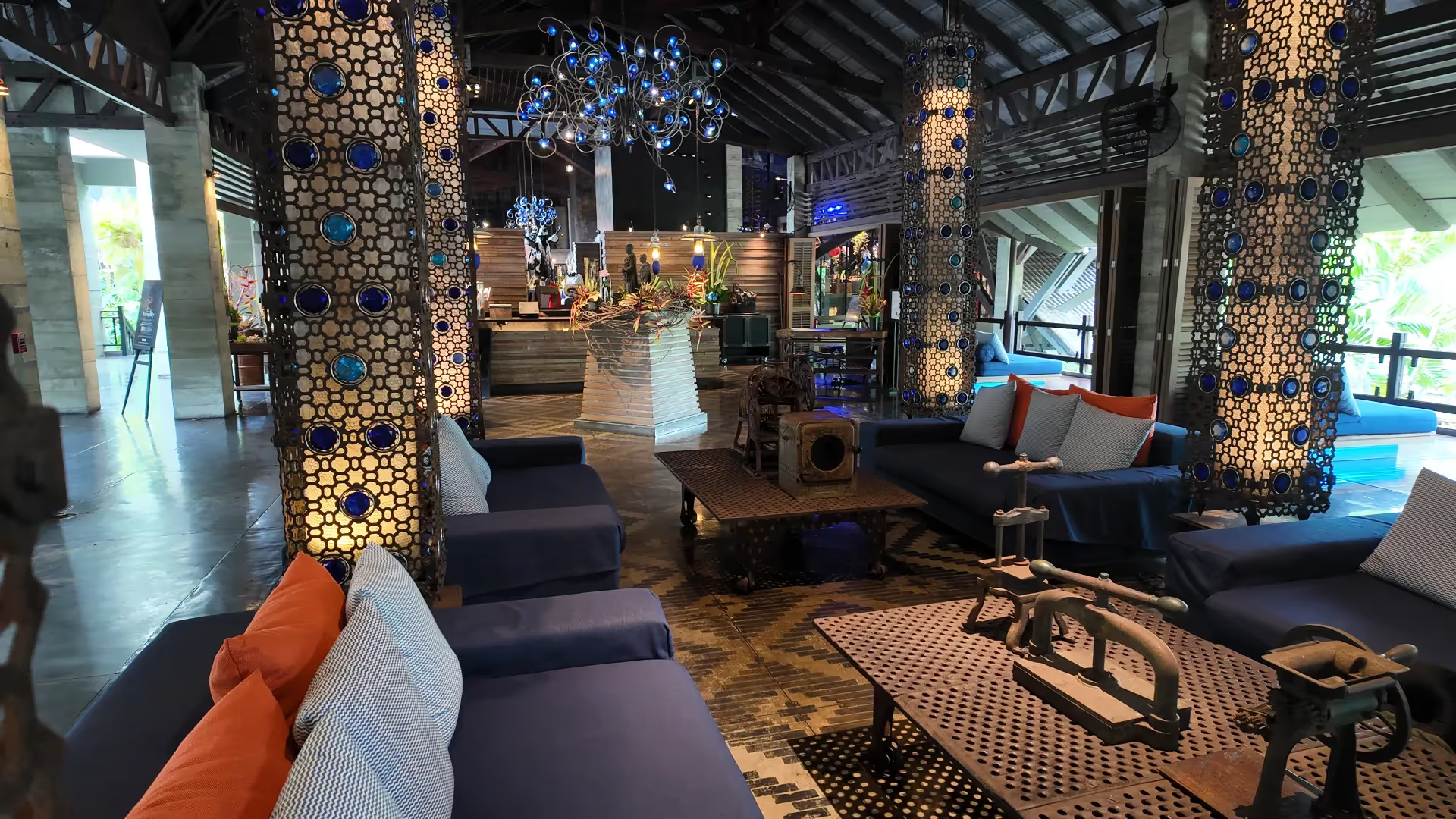
The Slate is a love letter to industrial honesty wrapped in tropical lushness. Steel beams rise like exposed ribs, timber reclaimed from warehouses is worked into ceiling trusses and furniture, and rusted tin panels are treated and repurposed as cladding, ceiling features, and decorative screens. Brushed concrete floors run through public spaces and suites, not because it’s trendy, but because it’s ideal for the tropics: cool underfoot, low maintenance, and built to age gracefully. Volcanic rock lines the pathways, its dark, porous texture contrasting with the greenery that almost swallows the buildings whole.
Located on Nai Yang Beach on the island’s quieter northwest coast, The Slate is just a five-minute drive from Phuket International Airport, yet it feels worlds away from the chaos of Patong. Arrival sets the tone. Through a custom steel-and-timber gateway, you’re greeted by a subtle Thai-Asian fragrance, spa-like and transportive, the sort of scent that makes you slow your pace without realising. Staff move like perfectly timed stagehands, their presence felt more than seen. The lobby is a layered set piece: exposed trusses with riveted steel plates, oversized fans mounted on custom brackets, pendant lamps made from old mining sieves, and columns clad in differently weathered tin panels, each one telling its own story.
The Slate is proof that maximalism, when done with intent, can feel luxurious. Bensley balances raw, weight-bearing structure with the lush chaos of nature. Old mining carts are planted with greenery, steel chains hang as sculpture, and lily ponds reflect the surrounding architecture. Pathways curve deliberately, framed by overhanging frangipani and palm fronds, so you never see too far ahead, it creates a sense of discovery. Every bench, screen, and light fixture feels like it’s been custom-made for the space, which it probably has; Bensley’s work rarely includes anything off-the-shelf.
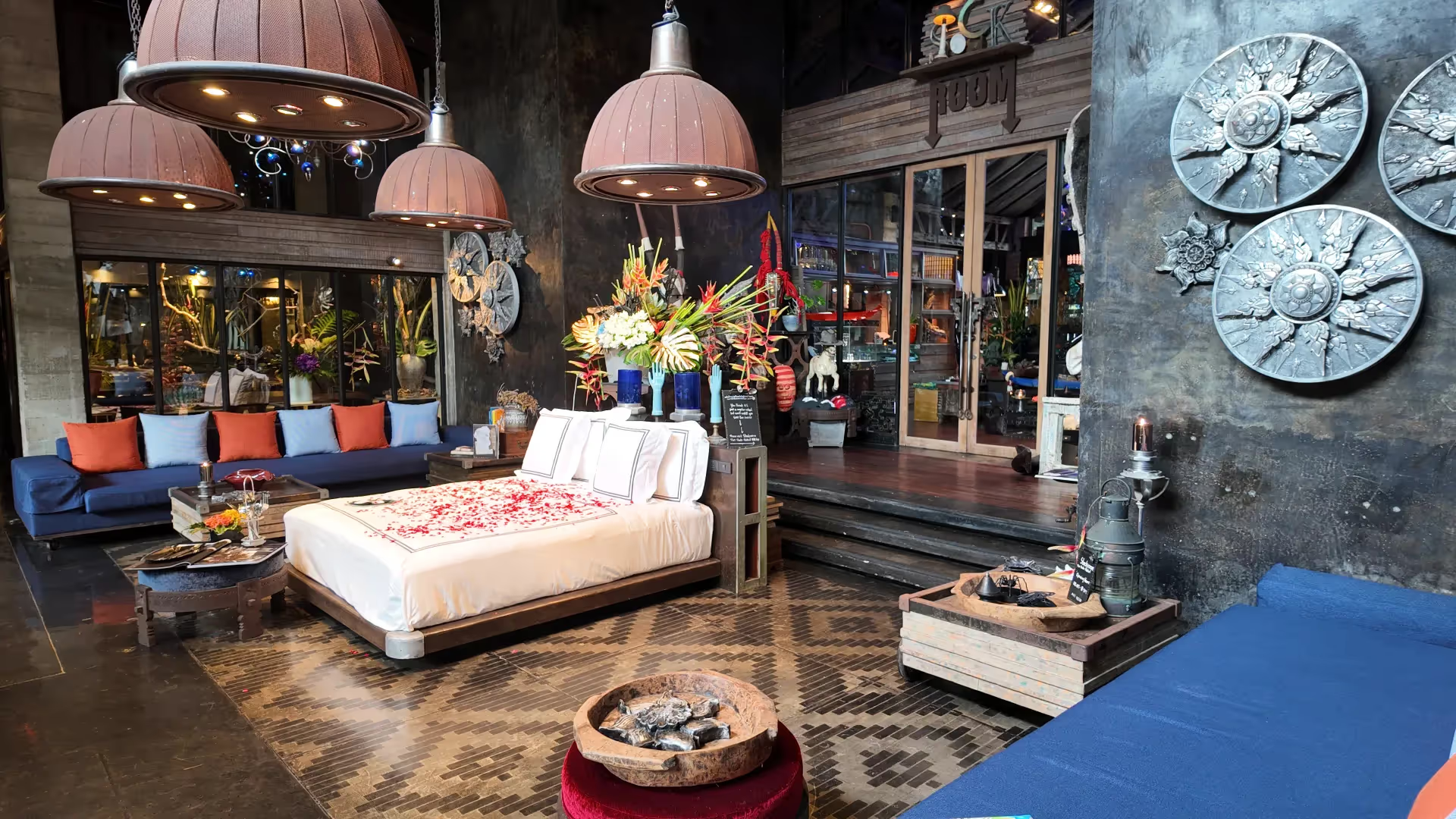
What makes The Slate feel so different from other resorts is not just the design vision, it’s the choice of materials and how they’ve been used. Every selection is both aesthetic and practical.
The result is a resort that’s visually rich but also “built to last” something you notice only if you’ve ever had to maintain a building in the tropics. Every choice considers Phuket’s humidity, heavy rains, and the corrosive effect of salty coastal air.
My 35 sqm suite was as much a design statement as it was a place to sleep. The bed’s solid hardwood frame sat against a timber-clad feature wall, flanked by side tables inset with hand-tooled leather. Furniture was bespoke: a solid timber desk and armchairs crafted from woven rattan (or synthetic wicker) with fabric-upholstered cushions for comfort and durability.
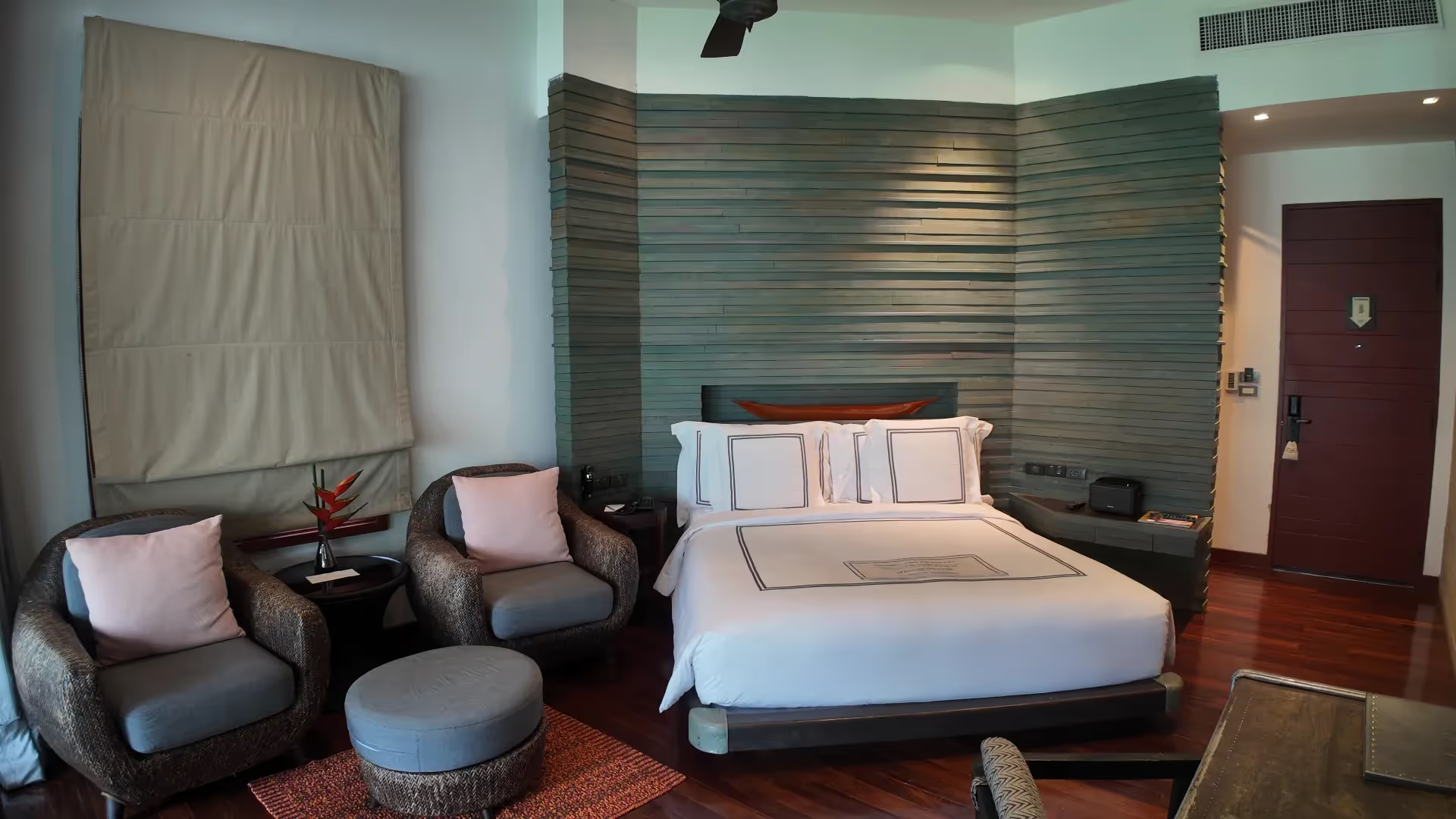
The walls were smooth-rendered concrete, painted in muted tones, with doors and windows of solid hardwood showing off their joinery rather than hiding it. The balcony looked out over the pool and jungle, with a freestanding cast-stone outdoor bath framed by vertical timber screens for privacy. Inside, the brushed concrete floors kept the space cool, and soft textiles in earthy tones balanced the harder industrial edges.
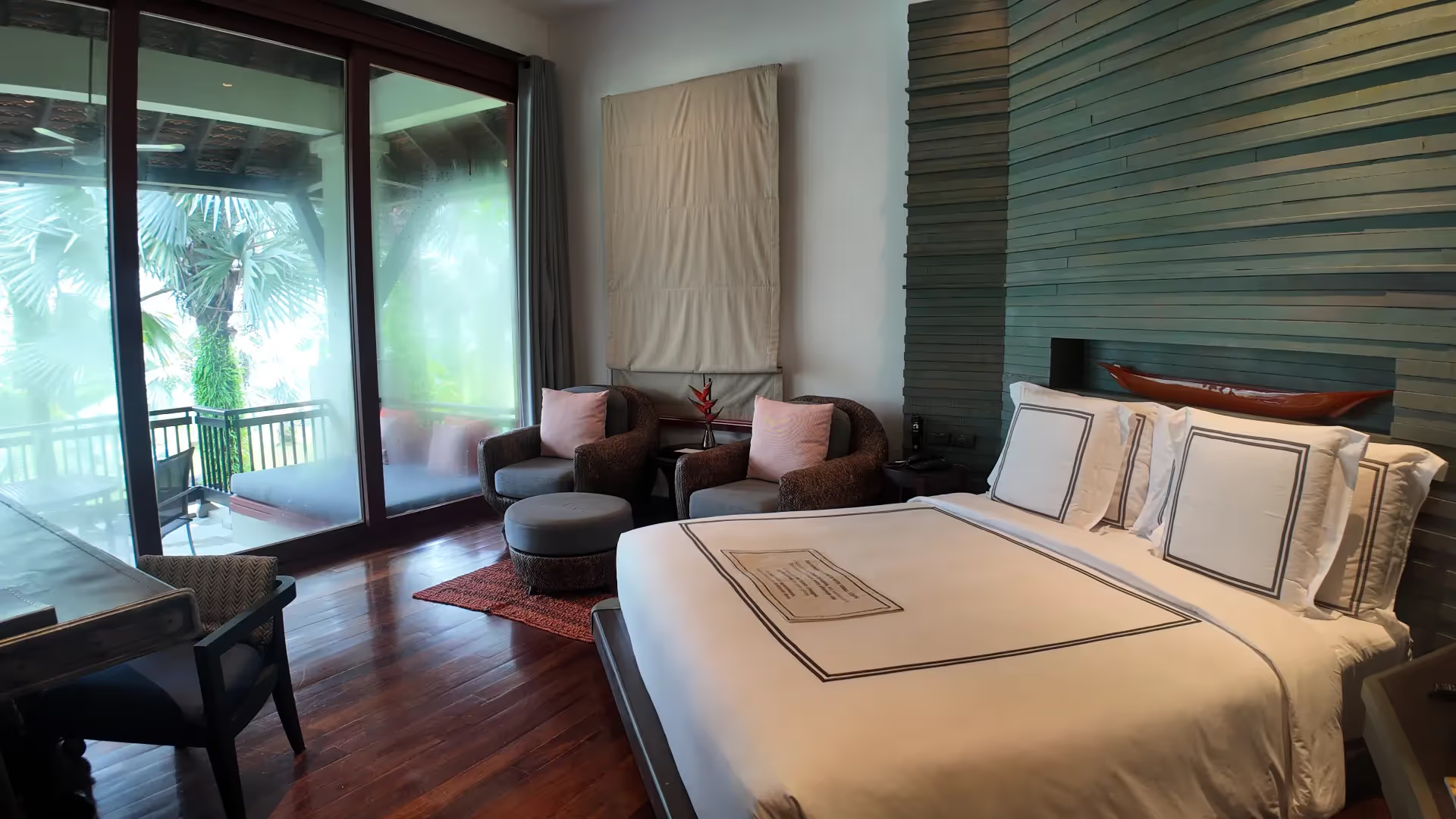
The room was functional and irregularly shaped, yet the design felt curated and expansive. Ample natural light made the space look larger and brighter during the day.
On a Muay Thai diet, I wasn’t exactly going to throw myself into a 12-course tasting menu, but the all-day dining restaurant had me covered, even gluten-free options, which are rare in Thailand. The breakfast spread doesn’t aim to compete with the theatrical gastronomy of Atlantis, The Royal, and that’s the beauty of it. Here, the focus is on quality, not spectacle. The dining spaces themselves follow the Bensley formula: open-air pavilions with timber and steel frames, reclaimed floorboard tables, leather-seated chairs stitched by hand, and lighting that changes the mood from bright and breezy in the morning to intimate and warm in the evening.
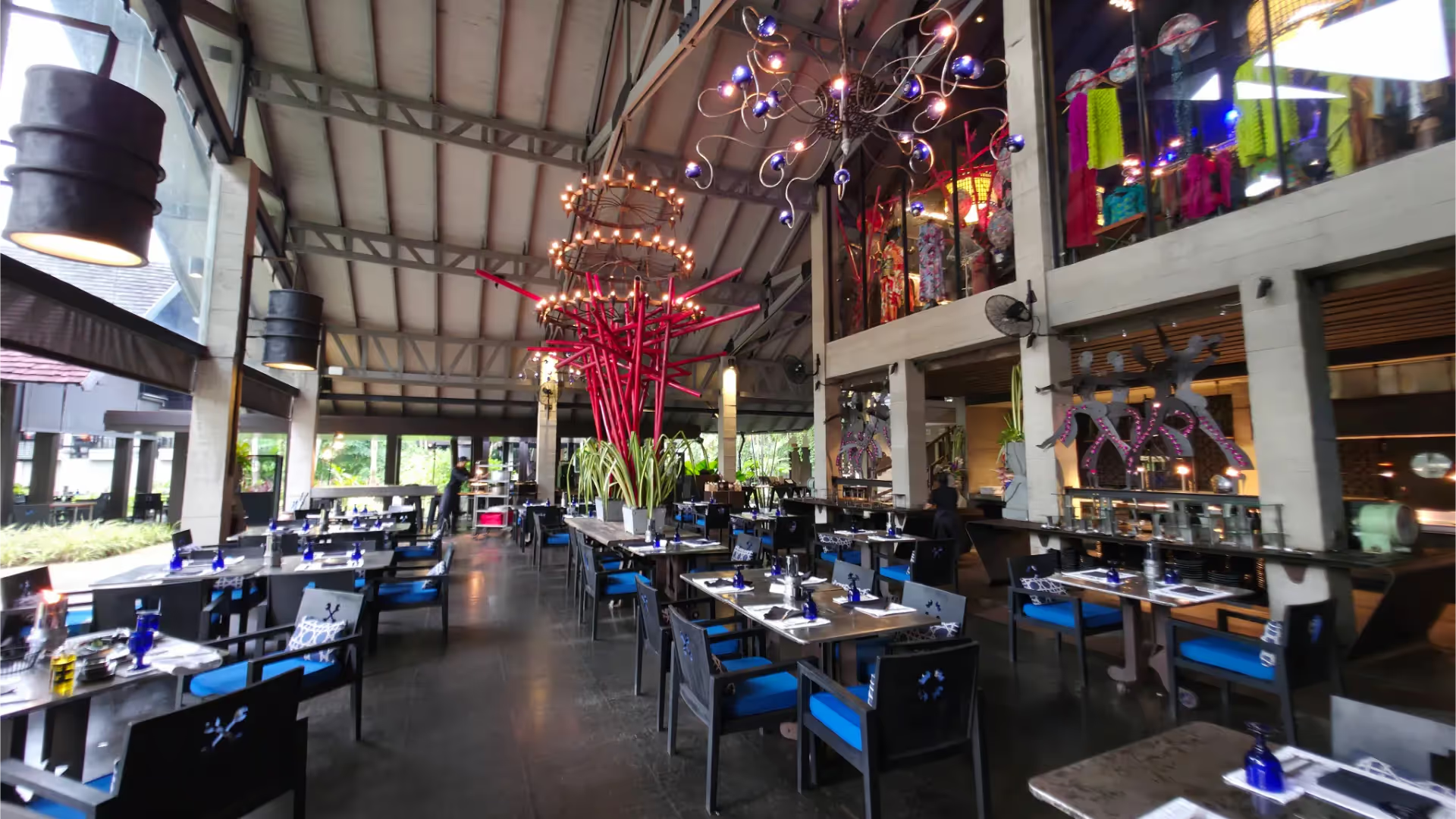

The Slate’s service has that rare combination of invisibility and precision. Take a wrong turn and someone appears in a buggy at just the right moment to guide you back, not because they’re following a script, but because the resort is designed with discreet back-of-house pathways that let staff move like ghosts. During monsoon showers, umbrellas arrive before you’ve even thought about needing one, and wet paths are cleared before your feet touch them.
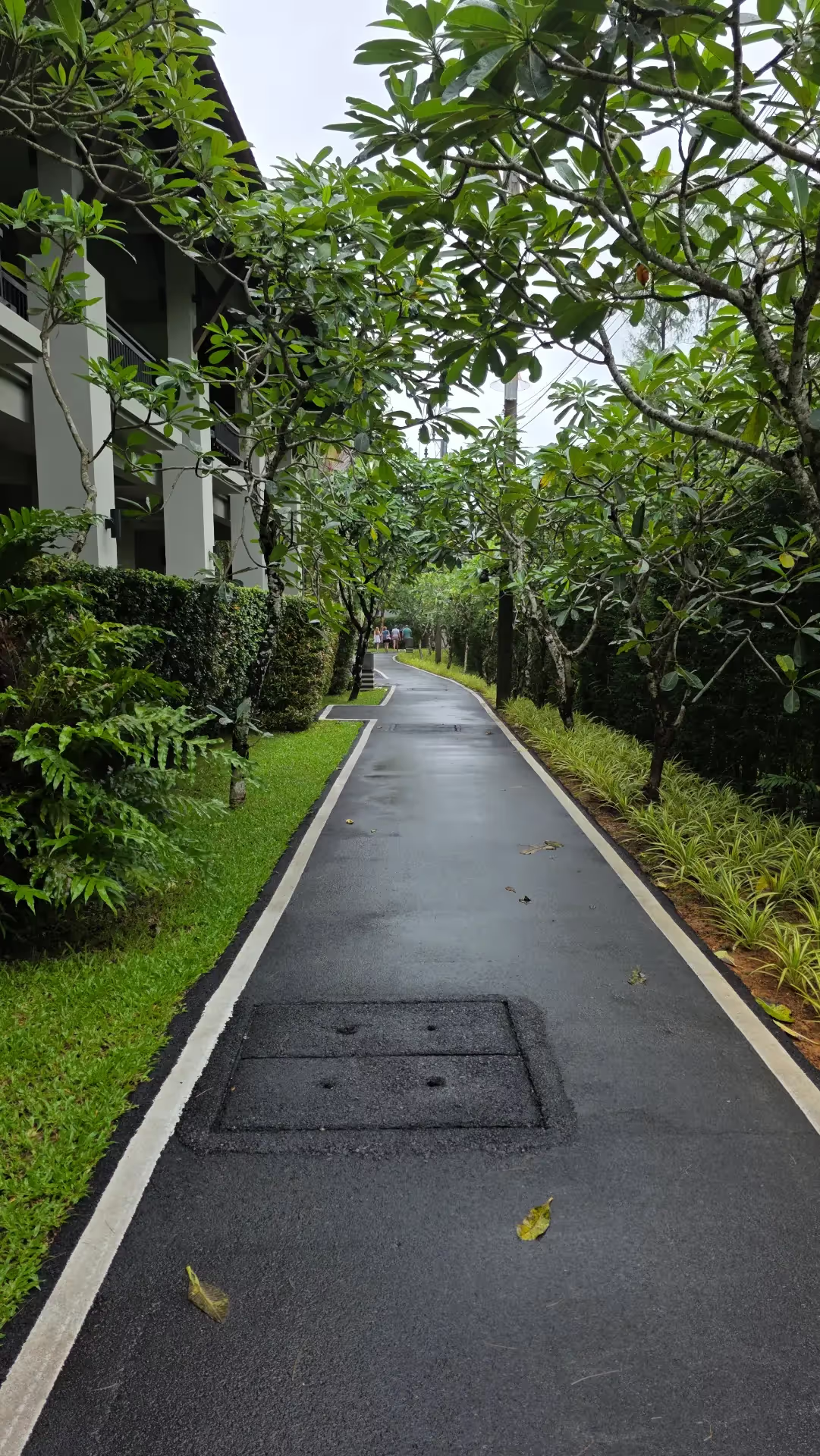
And truly, nothing beats Thai hospitality. People often say “wow” about the Middle East, but across Asia the warmth runs deeper, friendly, polite, welcoming not just to guests, but to one another. (Maybe it’s the soft Zen/Buddha playlist in the background, but everything here feels wrapped in serenity).
The resort’s 177 accommodations, including 7 private Pool Villas, are spread over 25 acres, so it never feels crowded. The landscaping is a study in controlled overgrowth, dense tropical planting that wraps around villas for privacy and softens every hard surface. Pools are lined with volcanic stone, their infinity edges merging with the gardens. The spa sits in its own enclave, with treatment rooms built from reclaimed teak and opening onto private gardens. Even the gym avoids the generic, an open-sided structure with a steel-framed roof and louvred panels for ventilation, so you don’t feel like you’re sweating in a box.

Having had countless massages across Thailand, two standouts for me were the Oasis Spa in Rawai and Coqoon Spa at The Slate in Phuket. At Coqoon, I opted for a CBD oil massage, something you won’t find in many places worldwide, and it was exceptional. Not only was the treatment deeply restorative, but it also felt like great value compared to other five-star resorts in Asia.
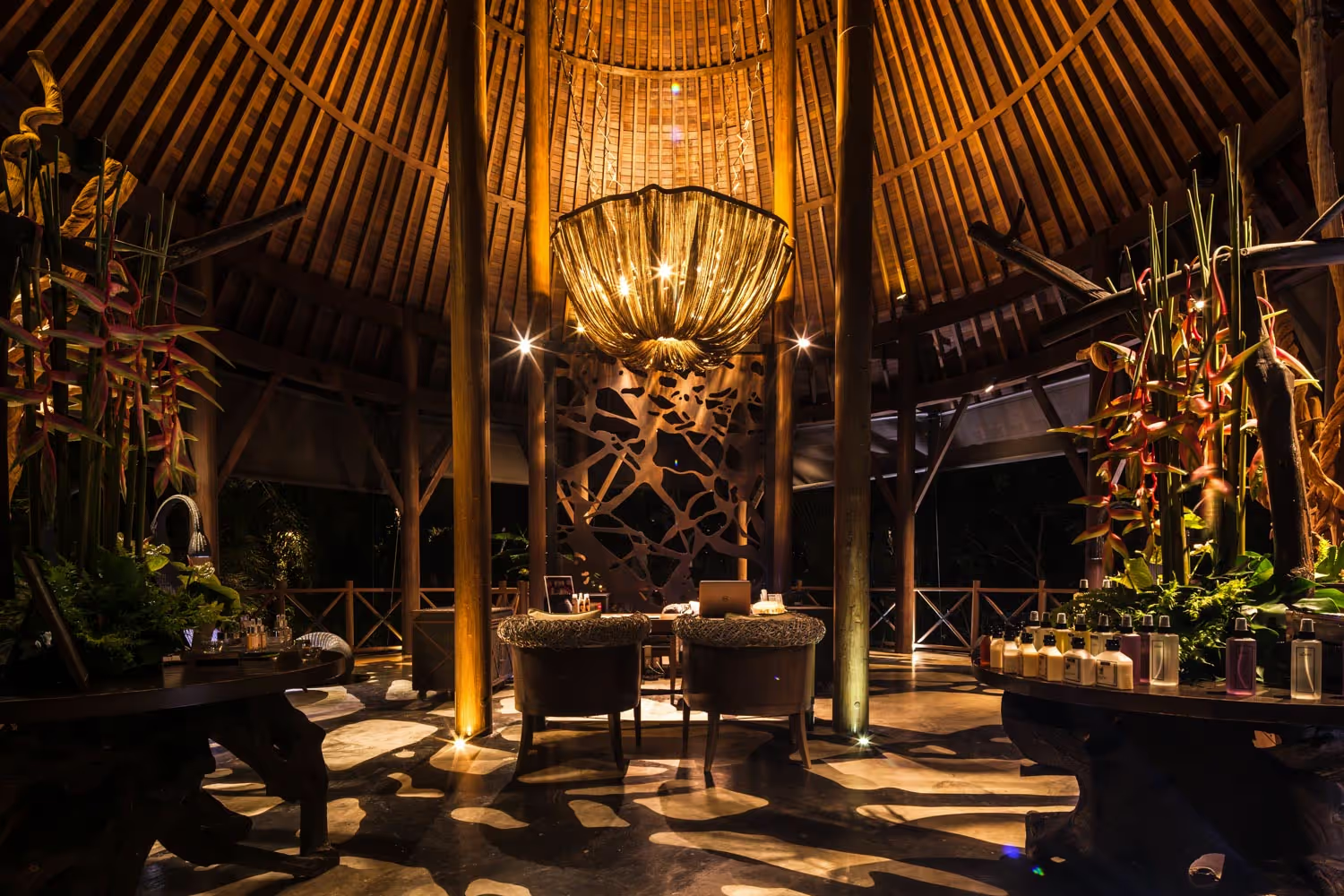
The resort itself caters to both families and solo travelers like myself. Through their app, you can join activities such as beach clean-ups, excursions, and trekking trips (at an extra cost), which makes it easy to blend relaxation with purpose. For fitness enthusiasts, the gym is fully equipped, whether you just want a light run or need to prep for a HYROX tournament. Add in a tennis court and a variety of other on-site activities, and there’s always something to do, rain or shine, ensuring guests of all ages stay engaged and entertained.
Some say The Slate could reach “world-class” status if it partnered with a big-name hotel brand i.e. Hilton, Marriott etc. Personally, I think that would ruin it. The quirks, the heritage, the slightly untamed personality, that’s what makes it special. Big brands excel at polish, but too often that polish sands away the soul. The Slate feels curated, not standardised, and that’s worth paying for.
What I also love is their quiet, genuine approach to sustainability. It’s not about shouting “we’re the most sustainable” or slapping a LEED Platinum label on the door or we’re part of DarkSky International, it’s about showing it through every part of the guest experience, from the food to the materials. It reminded me of the feeling I get at Six Senses properties: understated, authentic, and effectively smart.
I’m sure Krystal Prakaikaew Na-Ranong (owner) has had countless offers, but I hope she never gives in. Incredible work by Krystal, Claude, and the team.
Not everything is perfect (and I don’t expect it, really), and this is the part most property managers tend to skip to. The recycled room key, free drinks keychain / paper map are eco-friendly but bulky to carry. A single wearable wristband, like the one I had at Ritz-Carlton Nujuma (KSA), would be far more seamless. The resort app works but is slow to respond (maybe an hour); a WhatsApp-based concierge would feel more personal and immediate (But I can see why you went down this route, likely because many Chinese tourists rely on WeChat). And while the alphabetical zone navigation fits the “explorer” theme, I’m a door-number person, looping the same path twice isn’t my idea of fun unless it’s for exercise. On a smaller note, my shower leaked and flooded into the toilet area (a quick bit of mastic would easily fix it).
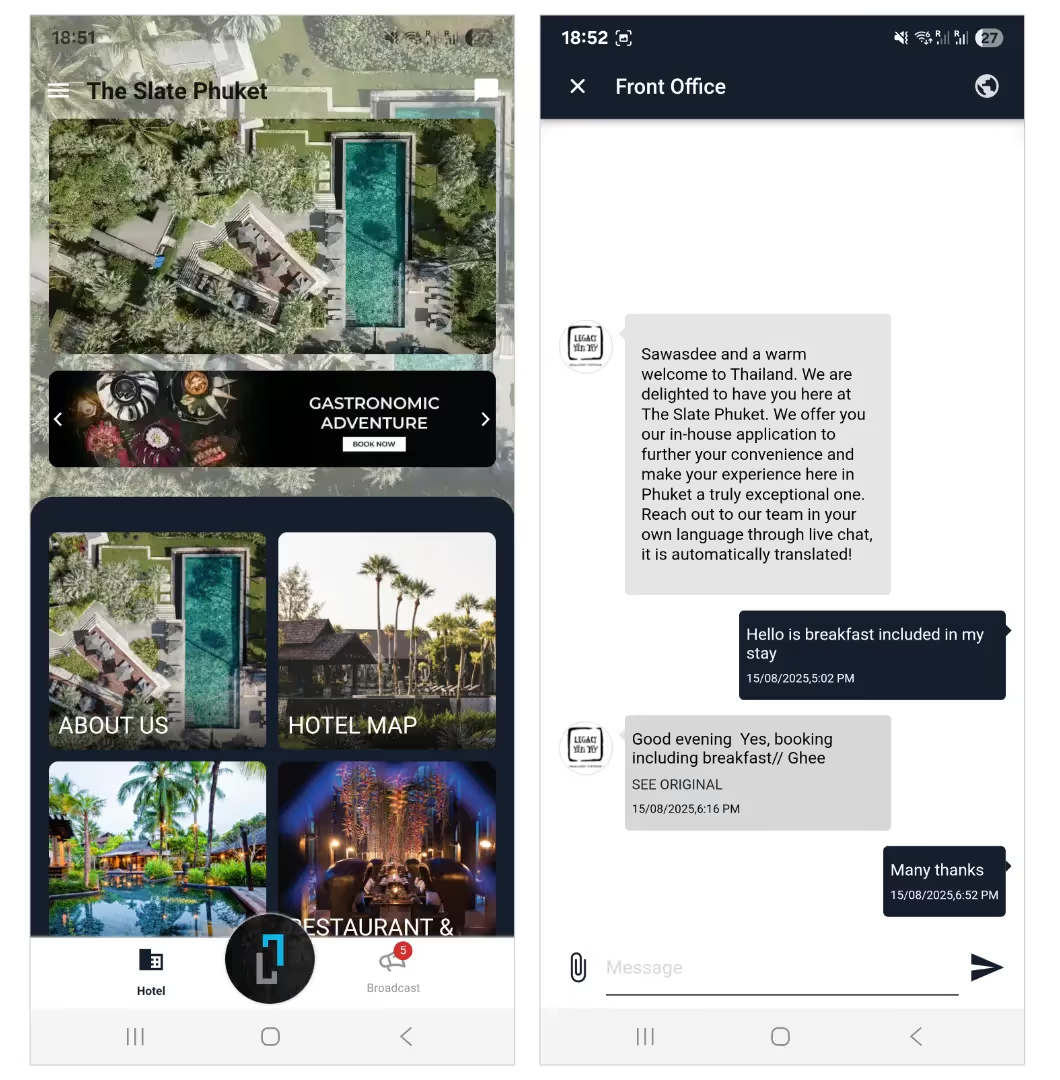
At AED 768 (THB 6,765) in low season, it was excellent value. Peak season can almost double the price, and I’d still pay up to AED 1,500 for what you get here. After months in Dubai’s sandpit, the smell of rain on concrete, abundance of ‘fresh’ greenery, the sound of it on tin roofs, and the sight of foliage dripping with water felt like luxury. Monsoon season amplified the calm pools, gardens, and dining spaces all felt private, with only the occasional tropical bird for company.
As a Virgo with a construction background, I’m annoyingly detail-obsessed and not easily impressed. But The Slate won me over. It’s not my usual style, and that’s exactly why I loved it. Great hotels don’t just cater to your preferences; they surprise you. And sometimes that surprise is worth more than any infinity pool or pillow menu. Even if a line was slightly off, a patch of wall unpainted, or a nail missing, I wouldn’t have noticed, because the rustic character of the property makes those imperfections feel intentional.
Many thanks to Wipaporn (SOR) Jokkua. This wasn’t a sponsored stay (none of mine are), but the fact that the team personally introduced themselves speaks volumes about their attention to detail. Grateful as well to the wider team for their warm hospitality.
Khàawp-khun khráp (until next time).